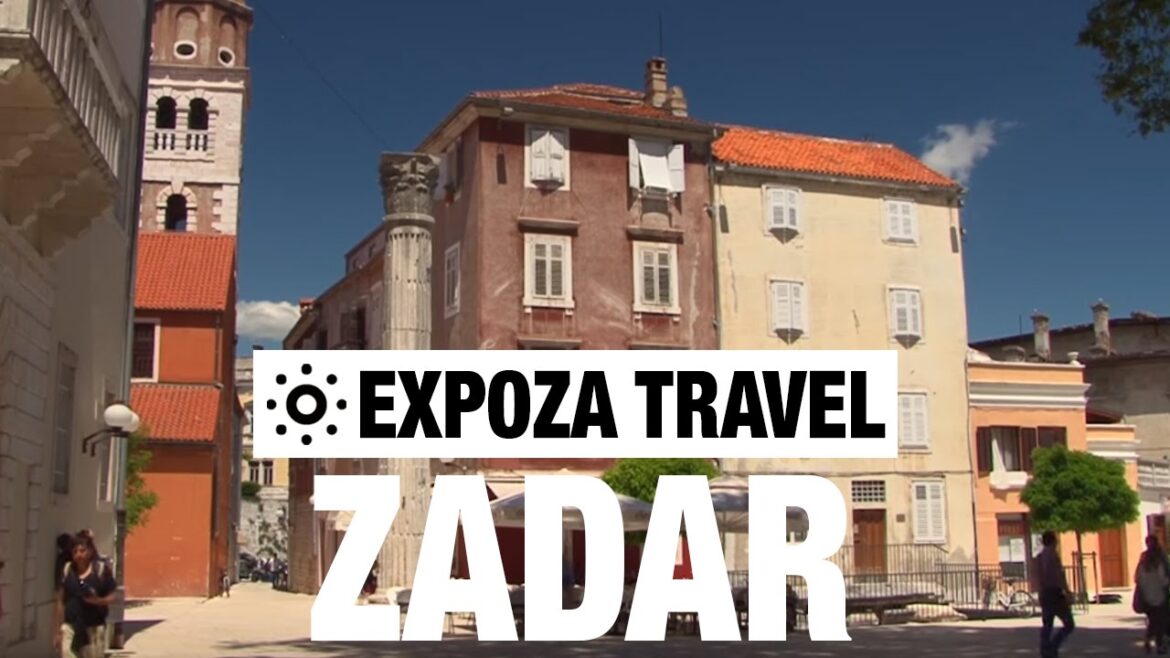This Post is a Collection of Public Facts, Historical Information & Best Public Travel Video Guides about Zadar Detailing about Important Sights & Attractions, Best Beaches, Food & Public Transport in Zadar
Zadar historically known as Zara, is the oldest continuously inhabited Croatian city. It is situated on the Adriatic Sea, at the northwestern part of Ravni Kotari region. Zadar serves as the seat of Zadar County and of the wider northern Dalmatian region. The city proper covers 25 km2 with a population of 75,082 in 2011, making it the second-largest city of the region of Dalmatia and the fifth-largest city in the country.
Zadar, with its rich historical significance, stands as a testament to the layers of history that have shaped this coastal city. Its roots date back to Roman times when it was known as Iadera, and it became an essential hub within the Roman Empire, renowned for its Forum, temples, and defensive walls. Over the centuries, Zadar witnessed the influence of various civilizations, including the Byzantines, Venetians, and even the Ottoman Empire. One of its most iconic landmarks, the Church of St. Donatus, built in the 9th century, is a remarkable example of pre-Romanesque architecture and serves as a link to its early Christian heritage. Zadar was also a pivotal city during the Croatian War of Independence in the 1990s, symbolizing the struggle for sovereignty and freedom.
Throughout its history, Zadar has been a melting pot of cultures and influences, reflecting the ebb and flow of different civilizations in the region. Today, the city’s historic significance is celebrated through its well-preserved architecture, archaeological sites, and museums, offering visitors a captivating journey through time and a deeper appreciation for its enduring heritage.
Getting There
- By Air: The Zadar Airport (ZAD) serves domestic and international flights. It’s located approximately 8 kilometers from the city center, and you can easily reach the city by taxi or bus.
- By Bus/Car: Zadar is well-connected by bus to other Croatian cities, making it accessible from Zagreb, Split, and beyond. You can also drive to Zadar using the country’s road network.
Top Attractions
- Old Town: Zadar’s historic center is a treasure trove of ancient architecture. Stroll through its narrow cobblestone streets, visit St. Donatus Church, and explore the Roman Forum.
- Sea Organ: This unique musical instrument is built into the seafront promenade. It creates hauntingly beautiful sounds as the waves wash over it, making it a mesmerizing experience, especially at sunset.
- Sun Salutation: Adjacent to the Sea Organ, the Sun Salutation is a large solar-powered installation that lights up in colorful patterns at night, offering a dazzling display.
- Kornati Islands National Park: Embark on a boat trip to the nearby Kornati Islands, a stunning archipelago known for its pristine nature, crystal-clear waters, and dramatic landscapes.
- Plitvice Lakes National Park: While a bit of a drive from Zadar, Plitvice Lakes is a UNESCO World Heritage site and a must-visit for nature lovers. It features cascading lakes and waterfalls in lush green surroundings.
- Church of St. Simeon: Admire the architecture of this 9th-century church, which houses the remains of St. Simeon. The nearby Romanesque cathedral of St. Anastasia is also worth a visit.
Local Culture
Zadar’s culture is deeply rooted in its history and Mediterranean influences. Here are some cultural highlights:
- Museums: Explore the Museum of Ancient Glass, Archaeological Museum, and Museum of Illusions for a glimpse into Zadar’s history and creativity.
- Events: If you visit in July and August, enjoy the Zadar Summer Theater Festival, a celebration of performing arts.
- Cuisine: Savor local dishes like seafood, lamb, and cheese. Try the traditional Pag cheese and Maraschino liqueur.
Sightseeing and Activities
- Climb the Bell Tower: Ascend the Bell Tower of St. Anastasia’s Cathedral for panoramic views of the city and surrounding islands.
- Beach Hopping: Zadar offers beautiful beaches like Kolovare Beach, Borik Beach, and the quieter Nin Beach.
- Wine Tasting: Take a wine tour to the nearby vineyards and savor Croatian wines like Plavac Mali and Pošip.
- Adventurous Activities: Go kayaking, paddleboarding, or even bungee jumping from the Maslenica Bridge for an adrenaline rush.
Best Things to Do
- Sunset Viewing: Head to the Greeting to the Sun and Sea Organ for an unforgettable sunset experience. Enjoy a cocktail at one of the nearby bars.
- Bike Ride: Rent a bike and explore the city’s scenic coastal paths and hidden coves.
- Shopping: Zadar’s markets and boutiques offer unique souvenirs, including local crafts, olive oil, and lavender products.
- Explore the Nearby Islands: Take day trips to islands like Ugljan, Pasman, and Dugi Otok for pristine beaches and charming villages.
Zadar Travel Video Guide by Expoza Travel
Historical Background of Zadar
- After the fall of Venice in 1797, Zadar came under Austrian rule until 1918, except for a period of short-term French rule (1805–1813), still remaining the capital of Dalmatia. During French rule the first newspaper in Croatian, Il Regio Dalmata – Kraglski Dalmatin, was published in Zadar (1806–1810). During the 19th century Zadar functioned as a center of the Croatian movement for cultural and national revival in a context of increasing polarization and politicization of ethnic identities between Croats and Dalmatian Italians.
- With the 1920 Treaty of Rapallo Zadar was given to the Kingdom of Italy. During World War II, it was bombed by the Allies and witnessed the evacuation of ethnic Italians. Partisans captured the city on 1 November 1944; in 1947 it officially became part of SR Croatia, a federal constituent of the SFR Yugoslavia, whose armed forces defended it in October 1991 from the Serb forces who aimed to capture it.
Zadar has become a Place of Prominence
Today Zadar is a historical center of Dalmatia, Zadar County’s principal political, cultural, commercial, industrial, educational, and transportation centre. Zadar is also the episcopal see of the Archdiocese of Zadar. Because of its rich heritage, Zadar is today one of the most popular Croatian tourist destinations, named “entertainment center of the Adriatic” by The Times and “Croatia’s new capital of cool” by The Guardian. UNESCO’s World Heritage Site list included the fortified city of Zadar as part of Venetian Works of Defence between 15th and 17th centuries: Stato da Terra – western Stato da Mar in 2017
Best Things To Do in Zadar – A Travel Guide by Rok Goes Around
Things To Do In Zadar Croatia as mentioned in the above Video Guide:
- 00:00 Introduction
- 00:42 City Walls & Land Gates
- 02:34 People’s Square
- 03:49 Kalelarga
- 04:31 Petar Zoranić Sqaure & Five Wells Square
- 06:10 Maraschino
- 07:03 Riva waterfront
- 07:55 Sea Organ & Greeting to the Sun
- 09:14 Kolovare Beach
- 10:01 Borik Beach
- 10:26 Nin’s Lagoon
- 11:10 Kornati National Park
- 12:00 Cathedral of St. Anastasia
- 13:18 Roman Forum & St. Donatus Church
Zadar Hidden Gems
Hidden gems in Zadar, Croatia, reveal the city’s lesser-known treasures that often escape the spotlight but are no less captivating than its famous attractions. These off-the-beaten-path experiences add depth to your exploration of Zadar, providing unique insights into its culture, history, and natural beauty. Here are some hidden gems in Zadar worth discovering:
- Queen Jelena Madijevka Park: Tucked away from the city’s hustle and bustle, this park offers a tranquil escape. Lush greenery, winding pathways, and serene viewpoints overlooking the sea make it a perfect spot for a leisurely stroll or a peaceful picnic.
- Church of St. Chrysogonus: While overshadowed by some of Zadar’s larger churches, this Romanesque gem deserves attention. Its historic architecture and serene atmosphere make it a peaceful place to reflect on the city’s past.
- The Forum’s Ruins: While the Roman Forum in Zadar is well-known, take some time to explore the less crowded corners of these ancient ruins. You can discover intricate carvings, inscriptions, and remnants of the city’s Roman history.
- The Grgur Ninski Statue: Located just outside the city’s walls, this massive statue of Bishop Grgur Ninski, created by famous sculptor Ivan Meštrović, is an iconic hidden gem. It’s believed that rubbing the statue’s big toe brings good luck, so don’t forget to give it a polish!
- Puntamika Peninsula: A peaceful escape from the city center, Puntamika offers picturesque beaches, charming cafes, and a relaxed atmosphere. It’s a great place to unwind and take in the scenic views of the Adriatic Sea.
- The Arsenal: Often overshadowed by Zadar’s more famous landmarks, The Arsenal is a historic building that once served as a shipyard. Today, it houses art exhibitions and cultural events, providing a unique blend of history and contemporary creativity.
- The Captain’s Tower: Located near the Land Gate, this small tower offers panoramic views of the city and its surroundings. It’s a hidden gem that’s often missed by tourists but rewards those who discover it.
- The Pillar of Shame: A historical curiosity, this stone column in Zadar’s Old Town once displayed the heads of criminals as a form of punishment. It serves as a reminder of the city’s complex history.
- Archaeological Museum Zadar: While not entirely hidden, this museum is often overlooked. It houses a fascinating collection of artifacts from the region, providing insights into Zadar’s ancient past.
- Sunset from Borik: While Zadar’s famous sunset at the Sea Organ is a must-see, consider watching the sunset from the Borik peninsula for a quieter and equally stunning experience.
Exploring these hidden gems in Zadar allows you to delve deeper into the city’s culture and history, uncovering its secrets while avoiding the crowds. These offbeat attractions offer a more intimate and authentic perspective of this charming Croatian city.


